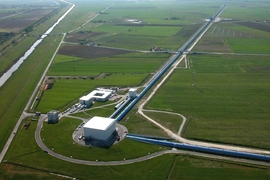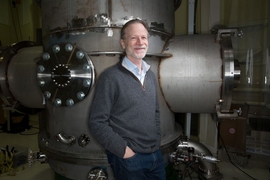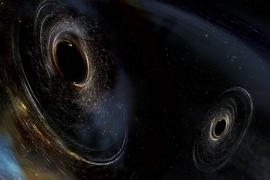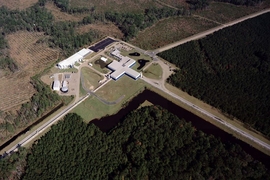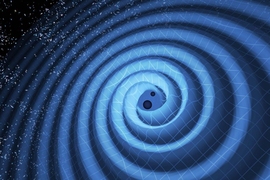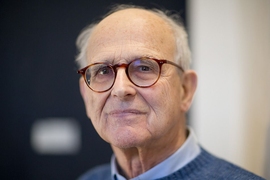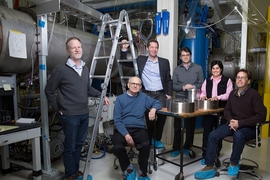The following news article is adapted from a press release issued by the Laser Interferometer Gravitational-wave Observatory (LIGO) Laboratory, in partnership with the LIGO Scientific Collaboration and Virgo Collaboration. LIGO is funded by the National Science Foundation (NSF) and operated by Caltech and MIT, which conceived and built the project.
The LIGO Scientific Collaboration and the Virgo collaboration report the first joint detection of gravitational waves with both the LIGO and Virgo detectors. This is the fourth announced detection of a binary black hole system and the first significant gravitational-wave signal recorded by the Virgo detector, and highlights the scientific potential of a three-detector network of gravitational-wave detectors.
The three-detector observation was made on Aug. 14 at 10:30:43 UTC. The two Laser Interferometer Gravitational-wave Observatory (LIGO) detectors, located in Livingston, Louisiana, and Hanford, Washington, and funded by the National Science Foundation (NSF), and the Virgo detector, located near Pisa, Italy, detected a transient gravitational-wave signal produced by the coalescence of two stellar mass black holes.
A paper about the event, known as GW170814, has been accepted for publication in the journal Physical Review Letters.
The detected gravitational waves — ripples in space and time — were emitted during the final moments of the merger of two black holes with masses about 31 and 25 times the mass of the sun and located about 1.8 billion light years away. The newly produced spinning black hole has about 53 times the mass of our sun, which means that about three solar masses were converted into gravitational-wave energy during the coalescence.
“This is just the beginning of observations with the network enabled by Virgo and LIGO working together,” says David Shoemaker of MIT, who is the spokesperson for the LIGO Scientific Collaboration. “With the next observing run planned for fall 2018 we can expect such detections weekly or even more often.”
“It is wonderful to see a first gravitational-wave signal in our brand new Advanced Virgo detector only two weeks after it officially started taking data,” says Jo van den Brand of Nikhef and VU University Amsterdam, who is spokesperson for the Virgo collaboration. “That’s a great reward after all the work done in the Advanced Virgo project to upgrade the instrument over the past six years.”
“Little more than a year and a half ago, NSF announced that its Laser Gravitational-wave Observatory had made the first-ever detection of gravitational waves resulting from the collision of two black holes in a galaxy a billion light-years away," says France Córdova, NSF director. "Today, we are delighted to announce the first discovery made in partnership between the Virgo Gravitational-Wave Observatory and the LIGO Scientific Collaboration, the first time a gravitational-wave detection was observed by these observatories, located thousands of miles apart. This is an exciting milestone in the growing international scientific effort to unlock the extraordinary mysteries of our universe.”
Advanced LIGO is a second-generation gravitational-wave detector consisting of the two identical interferometers in Hanford and Livingston, and uses precision laser interferometry to detect gravitational waves. Beginning operation in September 2015, Advanced LIGO has conducted two observing runs. The second “O2” observing run began on Nov. 30, 2016 and ended on Aug. 25, 2017.
Advanced Virgo is a second-generation instrument built and operated by the Virgo collaboration to search for gravitational waves. With the end of observations with the initial Virgo detector in October 2011, the integration of the Advanced Virgo detector began. The new facility was dedicated this past February, while its commissioning was ongoing. In April, the control of the detector at its nominal working point was achieved for the first time.
The Virgo detector joined the O2 run on Aug. 1, at 10:00 UTC. The real-time detection on Aug. 14 was triggered with data from all three LIGO and Virgo instruments. Virgo is, at present, less sensitive than LIGO, but two independent search algorithms based on all the information available from the three detectors demonstrated the evidence of a signal in the Virgo data as well.
Overall, the volume of universe that is likely to contain the source shrinks by more than a factor of 20 when moving from a two-detector network to a three-detector network. The sky region for GW170814 has a size of only 60 square degrees, less than one-tenth the region size with data from the two LIGO interferometers alone; in addition, the accuracy with which the source distance is measured benefits from the addition of Virgo.
“This increased precision will allow the entire astrophysical community to eventually make even more exciting discoveries, including multimessenger observations,” says Georgia Tech Professor Laura Cadonati, the deputy spokesperson for the LSC. “A smaller search area enables follow-up observations with telescopes and satellites for cosmic events that produce gravitational waves and emissions of light, such as the collision of neutron stars.”
“As we increase the number of observatories in the international gravitational wave network, we not only improve the source location, but we also recover improved polarization information that provides better information on the orientation of the orbiting objects as well as enabling new tests of Einstein’s theory,” says Fred Raab, LIGO associate director for observatory operations.
LIGO and Virgo’s partner electromagnetic facilities around the world didn’t identify a counterpart for GW170814, which was similar to the three prior LIGO observations of black hole mergers. Black holes produce gravitational waves but not light.
“With this first joint detection by the Advanced LIGO and Virgo detectors, we have taken one step further into the gravitational-wave cosmos,” says Caltech’s David H. Reitze, the executive director of the LIGO Laboratory. “Virgo brings a powerful new capability to detect and better locate gravitational-wave sources, one that will undoubtedly lead to exciting and unanticipated results in the future.”
LIGO is funded by NSF and operated by Caltech and MIT, which conceived and built the project. Financial support for the Advanced LIGO project was led by NSF with Germany (Max Planck Society), the U.K. (Science and Technology Facilities Council) and Australia (Australian Research Council) making significant commitments and contributions to the project. More than 1,200 scientists from around the world participate in the effort through the LIGO Scientific Collaboration, which includes the GEO Collaboration. Additional partners are listed at ligo.org/partners.php.
The Virgo collaboration consists of more than 280 physicists and engineers belonging to 20 different European research groups: six from Centre National de la Recherche Scientifique (CNRS) in France; eight from the Istituto Nazionale di Fisica Nucleare (INFN) in Italy; two in The Netherlands with Nikhef; the MTA Wigner RCP in Hungary; the POLGRAW group in Poland; Spain with the University of Valencia; and EGO, the laboratory hosting the Virgo detector near Pisa in Italy.
